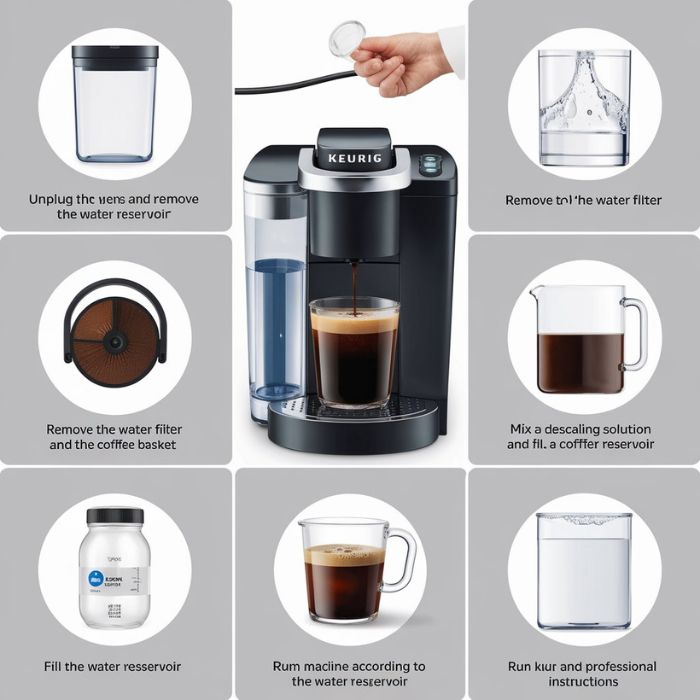Owning a Keurig comes with the perk of brewing coffee fast, but it also requires routine maintenance. Over time, minerals from the water can build up inside your Keurig, leading to clogs and inconsistent performance. If your coffee isn’t tasting as fresh or your machine isn’t working as efficiently, it’s time to descale your Keurig. This process not only helps extend the life of the machine but also ensures that you continue to get that perfect cup of coffee every time. Below, we dive into how to descale a Keurig and why it’s essential for both your coffee’s flavor and your machine’s longevity.
Why Descaling Your Keurig is Important
Descaling isn’t just a maintenance step; it’s a way to ensure your coffee tastes great every time. Tap water often contains minerals such as calcium and magnesium. When these minerals build up inside your Keurig, it can lead to slower brewing, clogged lines, and lower water temperatures. As a result, your coffee may taste off, weak, or take longer to brew. Regularly descaling your Keurig helps to remove these deposits and keeps the internal components running smoothly. This, in turn, extends the machine’s life and enhances the flavor and aroma of your coffee.
How Often Should You Descale a Keurig?
The frequency with which you should descale your Keurig depends largely on the hardness of your water and how often you use the machine. However, a general rule of thumb is to descale your Keurig every three to six months. If you use hard water or if your machine is showing signs of build-up, such as a slower brewing time or a bitter taste in your coffee, you might need to descale more often.
Signs That Your Keurig Needs Descaling
There are a few key signs that it’s time to descale your Keurig:
- The coffee tastes different – it may be bitter or less flavorful.
- Your Keurig takes longer to brew a cup.
- The machine is noisier than usual.
- You notice visible build-up or scaling inside the water reservoir.
- The “Descale” indicator light on your Keurig turns on (in models equipped with this feature).
If you’re experiencing any of these issues, it’s likely time to give your machine a good cleaning.
What You Need to Descale a Keurig
Descaling a Keurig is a simple process that requires just a few items, most of which you probably already have in your kitchen. Here’s what you’ll need:
- White vinegar or a Keurig descaling solution (specific for coffee machines)
- Clean water
- A large ceramic mug
- A soft cloth for wiping down the machine
Now that you have your materials ready, let’s dive into the step-by-step process.
How to Descale a Keurig Using White Vinegar
White vinegar is a common household item and is a highly effective natural descaler. It’s a great option if you don’t want to purchase a special descaling solution. Here’s how you can descale your Keurig using white vinegar:
Step 1: Empty the Water Reservoir
Start by unplugging your Keurig and removing the water reservoir. If there’s any remaining water in it, dump it out to ensure a fresh cleaning process.
Step 2: Fill the Reservoir with White Vinegar
Fill the water reservoir halfway with white vinegar. The acidic properties of vinegar are perfect for breaking down mineral deposits that build up inside the machine.
Step 3: Run a Cleaning Cycle
Place a large ceramic mug under the coffee dispenser. Then, plug in your Keurig and run a brewing cycle, but without inserting a K-cup. Let the vinegar solution run through the system. Repeat this process until the reservoir is empty.
Step 4: Let the Machine Sit
Once the vinegar solution has run through, let your Keurig sit for 30 minutes to an hour. This gives the vinegar enough time to break down any stubborn deposits inside the machine.
Step 5: Rinse the Machine
After waiting, empty any remaining vinegar solution and thoroughly rinse the reservoir with clean water. Refill the reservoir with fresh water and run several cycles to flush out any lingering vinegar taste.
How to Descale a Keurig Using a Descaling Solution
If you’d prefer to use a store-bought option, Keurig sells a specific descaling solution designed for their machines. The steps are almost identical to the vinegar method, with a few slight modifications:
Step 1: Empty the Water Reservoir
Start by dumping out any water that’s left in the Keurig reservoir.
Step 2: Add the Descaling Solution
Pour the descaling solution into the water reservoir according to the instructions on the bottle. Most descaling solutions recommend diluting with water, so be sure to check for specific measurements.
Step 3: Run the Descaling Cycle
Place a large mug under the coffee dispenser, and run a brewing cycle without a K-cup. This will allow the descaling solution to flow through the machine, cleaning the internal components. Continue the process until the reservoir is empty.
Step 4: Let the Solution Sit
Once you’ve run the solution through the system, let the machine sit for at least 30 minutes. This resting period ensures the solution has time to break down any mineral build-up effectively.
Step 5: Flush the Machine
After the wait, empty any remaining solution and refill the water reservoir with clean water. Run several clean water cycles to rinse out any descaling solution before brewing your next cup of coffee.
Maintaining Your Keurig Between Descaling Cycles
While descaling is an essential maintenance step, there are additional ways to keep your Keurig running smoothly between full cleanings:
- Use Filtered Water: Hard water contributes to mineral build-up, so using filtered or bottled water can slow down the rate at which scaling occurs inside the machine.
- Clean the Water Reservoir Regularly: Remove the water reservoir weekly and wash it with warm soapy water. This prevents any mold or algae from growing inside.
- Replace the Water Filter: Some Keurig models come with a water filter. Be sure to replace this every two months or as needed to keep your machine running efficiently.
- Run Plain Water Cycles: Every few days, run a plain water cycle (without a K-cup) to help flush out any coffee grounds that may clog the system.
How to Clean a Keurig Needle
In addition to descaling, cleaning the Keurig’s needle is crucial to maintaining consistent performance. The needle is responsible for puncturing the K-cup and delivering hot water, but it can easily become clogged with coffee grounds. Follow these steps to clean the Keurig needle:
- Unplug the Keurig: Always unplug the machine before attempting any manual cleaning to avoid injury.
- Remove the K-cup Holder: Carefully remove the K-cup holder from the machine.
- Use a Paper Clip: Straighten a paper clip and gently insert it into the needle to clear out any stuck grounds.
- Run a Water-Only Cycle: After cleaning the needle, run a water-only brewing cycle to ensure everything is flowing smoothly.
Troubleshooting Common Keurig Issues After Descaling
Sometimes, even after descaling, your Keurig may still have issues. Below are some common problems and tips to resolve them:
- Keurig Not Brewing After Descaling: If your Keurig isn’t brewing, try unplugging the machine for a few minutes, then plug it back in. You may also need to check for clogs in the needle or water line.
- Keurig Still Tasting Off After Descaling: Run additional clean water cycles. Lingering vinegar or descaling solution can affect the taste of your coffee.
- Keurig Pump Not Working: If the pump seems weak, it might be due to air trapped in the system. Fill the water reservoir and perform several water-only brews to fix this.
FAQs
How long should I wait after descaling my Keurig before making coffee?
After descaling, run at least three to four clean water cycles to flush out any residue. Once there’s no vinegar or solution taste, you’re ready to brew coffee.
Can I use lemon juice to descale my Keurig?
While lemon juice has similar acidic properties to vinegar, it’s not as effective at breaking down calcium deposits. It’s better to stick to white vinegar or a Keurig descaling solution for the best results.
Is it necessary to use the official Keurig descaling solution?
No, it’s not necessary, though the Keurig descaling solution is formulated specifically for the machine. White vinegar is an excellent and budget-friendly alternative.
Why does my Keurig say “descale” even after I’ve just cleaned it?
The descale light may remain on due to mineral build-up inside the machine. Try running an additional descaling cycle to clear any stubborn deposits.
Can I descale my Keurig with baking soda?
Baking soda is not recommended for descaling as it doesn’t have the acidic properties needed to dissolve mineral build-up. Stick to vinegar or a descaling solution.
How do I prevent mineral build-up in my Keurig?
The best way to prevent mineral build-up is to use filtered water in your Keurig. Regular cleaning and descaling also help keep your machine free of deposits.
Conclusion
Descaling your Keurig is an essential step in keeping your machine in top condition and ensuring that your coffee always tastes its best. Whether you choose to use white vinegar or a specialized descaling solution, the process is straightforward and can significantly extend the life of your machine. By keeping up with regular maintenance and cleaning, you’ll enjoy fresh, flavorful coffee every morning with minimal hassle.











